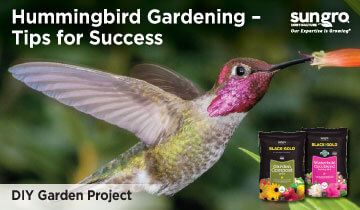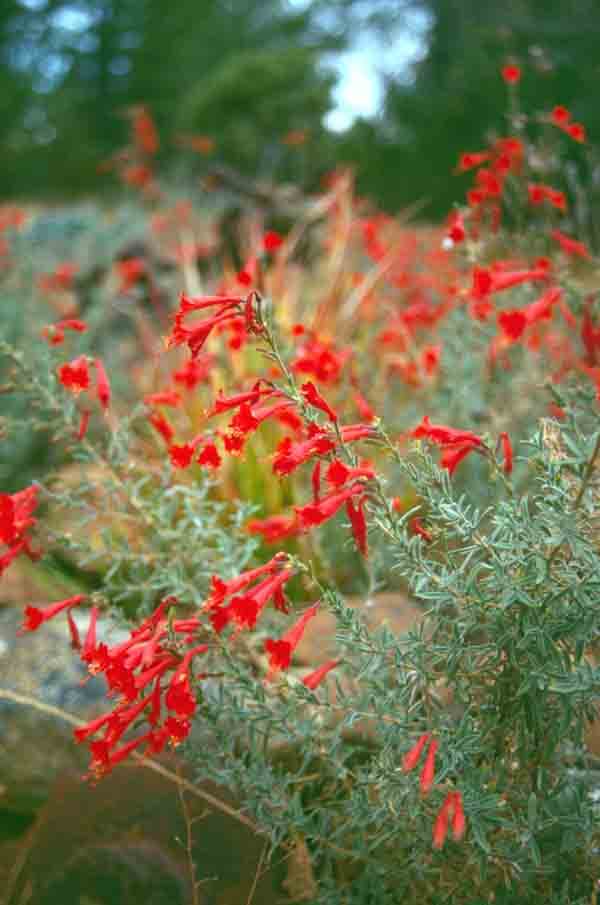
All red flowers draw hummingbirds, and tubular red-flowers make hummers go crazy. The birds recognize familiar species that have co-evolved with them for eons for pollination, with flowers held in such a way that hummers can hover and feed freely during extended nectar flows. Many hummingbird-pollinated species originate in hot, dry parts of the American Southwest and Mexico. These are the plants hummers fight over, guard jealously, and build their nests nearby. (Unless you’ve seen a rufous hummingbird in battle, you don’t know the territorial nature of hummingbirds!)
Hot Hummingbird Flowers
California Fuchsia

California fuchsia (Zauschneria californica, aka Epilobium canum var. garettii (USDA Hardiness Zones 7-10)), a native from New Mexico to southern Oregon, is one of the finest native hummingbird perennials for hot, dry gardens. Tolerant of full southern exposure and long, late-summer drought, this beauty, with its vivid tubular flowers, thrives in poor, well-drained soils. Hardy and rabbit resistant, this is an ideal plant for rocky outcrops, sloping properties, and perennial cottage gardens. Be sure to give it excellent drainage, and it will thrive.
Firecracker Plant
In striking contrast is the best container plant of all for the summertime hummingbird extravaganza, firecracker plant (Russellia equisetiformis (USDA Hardiness Zones 9-11)). It bears bright red tubular flowers on long, slender stems like horsehair. What makes this the perfect weekend-container-project plant is that it’s well-adapted to grow in taller pots. Firecracker plant weeps and cascades, so when you put it in pots, its beauty is revealed.

This Mexican perennial has also proved itself in the low desert where it has become a popular landscape plant. When cultivated on slopes or raised beds, the weeping foliage will cascade off the edge. When grown in-ground, the tips sweep the earth and build up internal foliage instead of growing longer.
The fine-textured stems of firecracker plant bloom nonstop until frost. They remain permanent garden fixtures in light or no-frost zones but must be sheltered in pots in colder winter zones. Once recognized by the local hummer population, they’ll return time and again to your patio to feed on this prolific plant. Firecracker plant is now widely available in garden centers. Give it a try this year to bring hummingbirds to your patio every day.
Use these planting tips for success: The most important thing is to find a tall pot that isn’t too big around. Consider knee-height the minimum. For a great contemporary look, choose dark pottery, so the plant appears to float in space as the dangling foliage grows longer. Plant your firecracker in Black Gold All Purpose Potting Mix, but leave at least 2 or 3 inches of the rim at the top. This greater fill space allows for more efficient hand watering.
Autumn Sage
Another arid-zone hummingbird plant that does well throughout the hot, dry west is autumn sage (Salvia greggii (USDA Hardiness Zones 7-10)). It is a super long-blooming, red-flowered native of Texas and Mexico. It’s been bred into many cultivated varieties to add a diversity of hues to your hummer garden. The comparable Southwest native, littleleaf sage (Salvia microphylla (USDA Hardiness Zones 7-10)), has equally lovely flowers, tiny leaves, and many varieties to choose from.
Lantana

Though technically adapted for butterfly pollination, the flowers of lantana (Lantana camara (USDA Hardiness Zones 10-11)) also lure hummingbirds. Lantana hybrids that are sterile and seedless, such as the pink and ivory ‘Pinkie’ and members of the Patriot™ series, prevent invasive volunteers and offer some stunning flower colors. Both creeping and upright forms of these shrubby plants are available. Where it’s colder, put them in hanging baskets, so hummers visit at eye level.
Attract hummingbirds naturally by avoiding feeders altogether; they are messy, a hassle, and flower nectar is healthier for these birds. If you plant properly, hummers will come, nest, and return year after year without you having to lift a finger.


